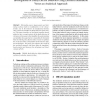Free Online Productivity Tools
i2Speak
i2Symbol
i2OCR
iTex2Img
iWeb2Print
iWeb2Shot
i2Type
iPdf2Split
iPdf2Merge
i2Bopomofo
i2Arabic
i2Style
i2Image
i2PDF
iLatex2Rtf
Sci2ools
ATS
2005
IEEE
2005
IEEE
Investigations of Faulty DRAM Behavior Using Electrical Simulation Versus an Analytical Approach
Abstract: Fabrication process improvements and technology scaling results in modifications in the characteristics and in the behavior of manufactured memory chips, which also modifies the faulty behavior of the memory. This paper introduces an analytical (equation-based) method to give a rough analysis of the faulty behavior of cell opens in the memory, that simplifies the understanding and identifies the major factors responsible for the faulty behavior. Having these factors makes it easier to optimize the circuit and allows extrapolation of the behavior of future technologies. The paper also compares the results of the analytical approach with those from the simulationbased analysis and discusses the advantages and disadvantages of both. Key words: DRAMs, faulty behavior, defect simulation, analytical evaluation, memory testing.
ATS 2005 | Fabrication Process Improvements | Faulty Behavior | Hardware | Manufactured Memory Chips |
| Added | 24 Jun 2010 |
| Updated | 24 Jun 2010 |
| Type | Conference |
| Year | 2005 |
| Where | ATS |
| Authors | Zaid Al-Ars, Said Hamdioui, Jörg E. Vollrath |
Comments (0)

